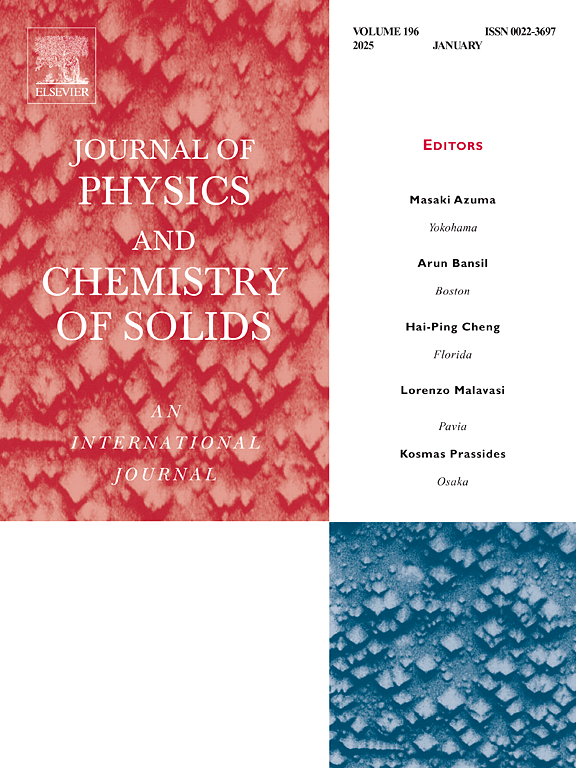Heterojunctions based on metal layer double hydroxide with Bi2WO6 as efficient solar photocatalyst and antimicrobial agent
IF 4.9
3区 材料科学
Q2 CHEMISTRY, MULTIDISCIPLINARY
引用次数: 0
Abstract
Photocatalysis is a highly prospective oxidation technology for the elimination of organic and biological pollutants. There is a considerable and urgent need to develop economic treatment methods that are cost-effective and energy resilient. Herein, pure Zn–Al and Zn–Ti Layered double hydroxides (LDHs) photocatalysts and hybrid with Bi2WO6 were constructed using a hydrothermal process. The obtained photocatalysts were examined for their ability to disinfect gram-positive bacterial strains named Staphylococcus aureus using the agar disk diffusion approach, as well as their photocatalytic ability for photodegrading methylene blue (MB) under solar energy. The findings indicated that the obtained Zn–Ti/Bi2WO6 LDH nanocomposite with a mass ratio of 10 % of Bi2WO6 exhibited the best antibacterial efficacy against S. aureus, with a mean inhibition region diameter of 25.7 mm. Moreover, Zn–Ti/Bi2WO6 LDH demonstrated remarkable photodegradation of MB dye as a model pollutant compared to the other catalysts with improved photocatalytic ability of 93 %. The rate constant of Zn–Ti/Bi2WO6 LDH was enhanced 6 times greater than either Bi2WO6 or Zn–Ti LDH. There was also excellent recyclability for five consecutive runs with slightly reduction of the photocatalytic ability using the obtained Zn–Ti/Bi2WO6 LDH nanocomposite. Mott-Schottky plots analysis, electrochemical impedance, isoelectric point (pHIEP), trapping experiments and bandgap calculations were performed to have a deep insight into the photocatalytic mechanism of the Zn–Ti/Bi2WO6 catalyst. This work could be expected to address of ultrathin S-scheme Zn–Ti/Bi2WO6 LDH heterostructure for developing stable and efficient photocatalysts and understanding the photocatalysis applications under solar energy.
以Bi2WO6为高效太阳光催化剂和抗菌剂的金属层双氢氧化物异质结
光催化是一种极具发展前景的去除有机和生物污染物的氧化技术。迫切需要开发具有成本效益和能源弹性的经济处理方法。本文采用水热法制备了纯Zn-Al和Zn-Ti层状双氢氧化物(LDHs)光催化剂及其与Bi2WO6的杂化反应。利用琼脂盘扩散法检测了所获得的光催化剂对革兰氏阳性菌株金黄色葡萄球菌的消毒能力,以及在太阳能下光催化降解亚甲基蓝(MB)的能力。结果表明,制备的Bi2WO6质量比为10%的Zn-Ti /Bi2WO6 LDH纳米复合材料对金黄色葡萄球菌的抑菌效果最好,平均抑菌区直径为25.7 mm。此外,与其他催化剂相比,Zn-Ti /Bi2WO6 LDH作为模型污染物对MB染料的光降解效果显著,光催化能力提高了93%。Zn-Ti /Bi2WO6 LDH的速率常数比Bi2WO6和Zn-Ti LDH提高了6倍。在连续5次循环中,获得的Zn-Ti /Bi2WO6 LDH纳米复合材料的光催化能力略有降低,并且具有良好的可回收性。通过Mott-Schottky图分析、电化学阻抗、等电点(pHIEP)、捕获实验和带隙计算,深入了解Zn-Ti /Bi2WO6催化剂的光催化机理。这项工作有望为超薄S-scheme Zn-Ti /Bi2WO6 LDH异质结构的开发提供稳定高效的光催化剂,并了解其在太阳能下的光催化应用。
本文章由计算机程序翻译,如有差异,请以英文原文为准。
求助全文
约1分钟内获得全文
求助全文
来源期刊
CiteScore
7.80
自引率
2.50%
发文量
605
审稿时长
40 days
期刊介绍:
The Journal of Physics and Chemistry of Solids is a well-established international medium for publication of archival research in condensed matter and materials sciences. Areas of interest broadly include experimental and theoretical research on electronic, magnetic, spectroscopic and structural properties as well as the statistical mechanics and thermodynamics of materials. The focus is on gaining physical and chemical insight into the properties and potential applications of condensed matter systems.
Within the broad scope of the journal, beyond regular contributions, the editors have identified submissions in the following areas of physics and chemistry of solids to be of special current interest to the journal:
Low-dimensional systems
Exotic states of quantum electron matter including topological phases
Energy conversion and storage
Interfaces, nanoparticles and catalysts.

 求助内容:
求助内容: 应助结果提醒方式:
应助结果提醒方式:


